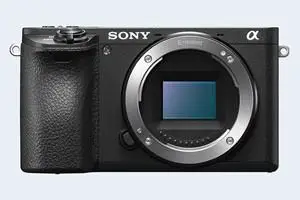Canon XC10 vs Sony A6500
The Canon XC10 and the Sony Alpha A6500 are two enthusiast cameras that were announced, respectively, in April 2015 and October 2016. The XC10 is a fixed lens compact, while the A6500 is a mirrorless interchangeable lens camera. The cameras are based on an one-inch (XC10) and an APS-C (A6500) sensor. The Canon has a resolution of 12 megapixels, whereas the Sony provides 24 MP.
Below is an overview of the main specs of the two cameras as a starting point for the comparison.

Check XC10 offers at
ebay.com

Check A6500 offers at
ebay.com
Going beyond this snapshot of core features and characteristics, what are the differences between the Canon XC10 and the Sony Alpha A6500? Which one should you buy? Read on to find out how these two cameras compare with respect to their body size, their imaging sensors, their shooting features, their input-output connections, and their reception by expert reviewers.
Body comparison
The physical size and weight of the Canon XC10 and the Sony A6500 are illustrated in the side-by-side display below. The two cameras are presented according to their relative size. Three consecutive views from the front, the top, and the rear side are shown. All width, height and depth dimensions are rounded to the nearest millimeter.
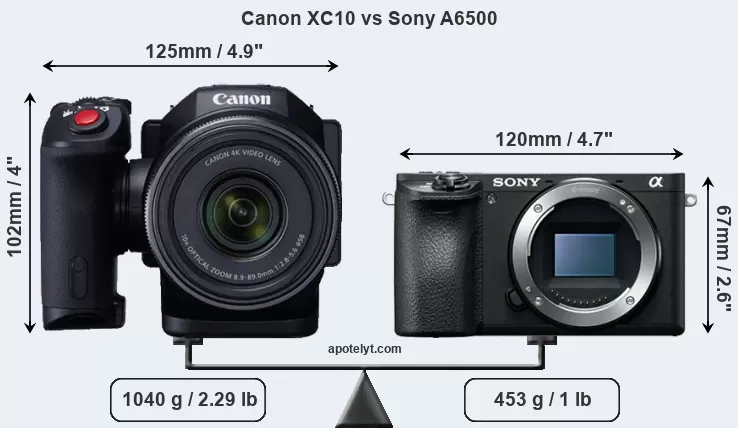
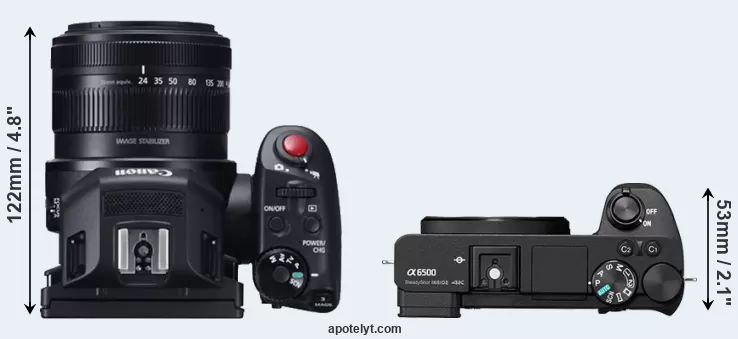
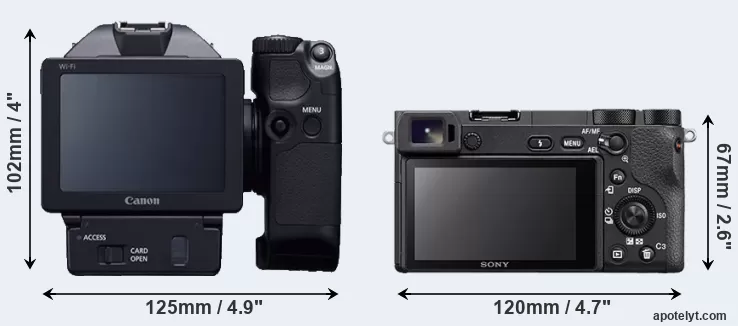
If the front view area (width x height) of the cameras is taken as an aggregate measure of their size, the Sony A6500 is considerably smaller (37 percent) than the Canon XC10. It is noteworthy in this context that the A6500 is splash and dust-proof, while the XC10 does not feature any corresponding weather-sealing.
The above size and weight comparisons are to some extent incomplete and possibly misleading, as the XC10 has a lens built in, whereas the A6500 is an interchangeable lens camera that requires a separate lens. Attaching the latter will add extra weight and bulk to the setup. You can compare the optics available for the A6500 and their specifications in the Sony E-Mount Lens Catalog.
Concerning battery life, the XC10 gets 370 shots out of its Canon LP-E6N battery, while the A6500 can take 350 images on a single charge of its Sony NP-FW50 power pack. The battery packs of both cameras can be charged via USB, which can be very convenient when travelling.
The following table provides a synthesis of the main physical specifications of the two cameras and other similar ones. If you want to switch the focus of the display and review another camera pair, you can move across to the CAM-parator tool and choose from the broad selection of possible camera comparisons there.

| Camera Model |
Camera Width |
Camera Height |
Camera Depth |
Camera Weight |
Battery Life |
Weather Sealing |
Camera Launch |
Launch Price |
Street Price |
||
|---|---|---|---|---|---|---|---|---|---|---|---|
| 1. | Canon XC10 | 125 mm | 102 mm | 122 mm | 1040 g | 370 | n | Apr 2015 | EUR 2 199 | ebay.com | |
| 2. | Sony A6500 | 120 mm | 67 mm | 53 mm | 453 g | 350 | Y | Oct 2016 | EUR 1 699 | ebay.com | |
| 3. | Canon G1 X Mark II | 116 mm | 74 mm | 66 mm | 553 g | 240 | n | Feb 2014 | EUR 849 | ebay.com | |
| 4. | Canon G5 X | 112 mm | 76 mm | 44 mm | 353 g | 210 | n | Oct 2015 | EUR 789 | ebay.com | |
| 5. | Canon G7 X | 103 mm | 60 mm | 40 mm | 304 g | 210 | n | Sep 2014 | EUR 649 | ebay.com | |
| 6. | Canon G7 X Mark II | 106 mm | 61 mm | 42 mm | 319 g | 265 | n | Feb 2016 | EUR 685 | ebay.com | |
| 7. | Canon G9 X | 98 mm | 58 mm | 31 mm | 209 g | 220 | n | Oct 2015 | EUR 499 | ebay.com | |
| 8. | Canon SX60 | 128 mm | 93 mm | 114 mm | 650 g | 340 | n | Sep 2014 | EUR 529 | ebay.com | |
| 9. | Fujifilm X30 | 119 mm | 72 mm | 60 mm | 423 g | 470 | n | Aug 2014 | EUR 549 | ebay.com | |
| 10. | Nikon P900 | 140 mm | 103 mm | 137 mm | 899 g | 360 | n | Mar 2015 | EUR 619 | ebay.com | |
| 11. | Olympus PEN-F | 125 mm | 72 mm | 37 mm | 427 g | 330 | n | Jan 2016 | EUR 1 199 | ebay.com | |
| 12. | Panasonic FZ2000 | 138 mm | 102 mm | 135 mm | 915 g | 350 | n | Sep 2016 | EUR 1 249 | amazon.com | |
| 13. | Panasonic GX8 | 133 mm | 78 mm | 63 mm | 487 g | 330 | Y | Jul 2015 | EUR 1 199 | ebay.com | |
| 14. | Panasonic LX100 | 115 mm | 66 mm | 55 mm | 393 g | 300 | n | Sep 2014 | EUR 799 | ebay.com | |
| 15. | Sony A6300 | 120 mm | 67 mm | 49 mm | 404 g | 400 | Y | Feb 2016 | EUR 1 099 | ebay.com | |
| 16. | Sony A6600 | 120 mm | 67 mm | 69 mm | 503 g | 810 | Y | Aug 2019 | EUR 1 599 | amazon.com | |
| 17. | Sony A6700 | 122 mm | 69 mm | 64 mm | 493 g | 570 | Y | Jul 2023 | EUR 1 699 | amazon.com | |
| Note: Measurements and pricing do not include easily detachable parts, such as add-on or interchangeable lenses or optional viewfinders. | |||||||||||
The price is, of course, an important factor in any camera decision. The listed launch prices provide an indication of the market segment that the manufacturer of the cameras have been targeting. Usually, retail prices stay at first close to the launch price, but after several months, discounts become available. Later in the product cycle and, in particular, when the replacement model is about to appear, further discounting and stock clearance sales often push the camera price considerably down.
Sensor comparison
The size of the sensor inside a digital camera is one of the key determinants of image quality. All other things equal, a large sensor will have larger individual pixel-units that offer better low-light sensitivity, wider dynamic range, and richer color-depth than smaller pixels in a sensor of the same technological generation. Moreover, a large sensor camera will give the photographer more control over depth-of-field in the image and, thus, the ability to better isolate a subject from the background. On the downside, larger sensors tend to be more expensive and lead to bigger and heavier cameras and lenses.
Of the two cameras under consideration, the Canon XC10 features an one-inch sensor and the Sony A6500 an APS-C sensor. The sensor area in the A6500 is 198 percent bigger. As a result of these sensor size differences, the cameras have a format factor of, respectively, 2.75 and 1.5. The sensor in the XC10 has a native 4:3 aspect ratio, while the one in the A6500 offers a 3:2 aspect.
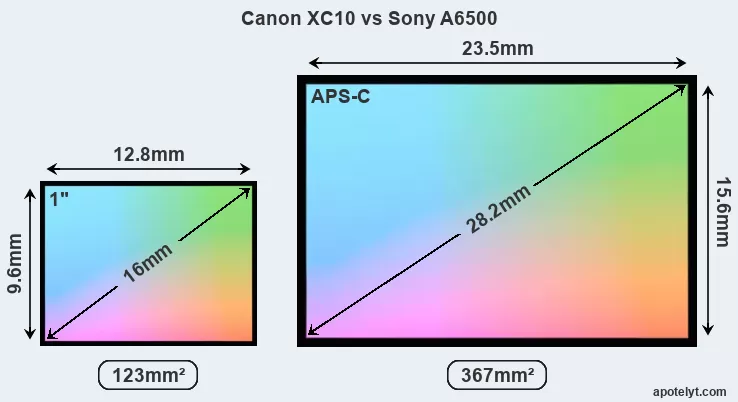
With 24MP, the A6500 offers a higher resolution than the XC10 (12MP), but the A6500 nevertheless has larger individual pixels (pixel pitch of 3.91μm versus 3.20μm for the XC10) due to its larger sensor. Moreover, the A6500 is a somewhat more recent model (by 1 year and 5 months) than the XC10, and its sensor might have benefitted from technological advances during this time that further enhance the light gathering capacity of its pixel-units.
The resolution advantage of the Sony A6500 implies greater flexibility for cropping images or the possibility to print larger pictures. The maximum print size of the A6500 for good quality output (200 dots per inch) amounts to 30 x 20 inches or 76.2 x 50.8 cm, for very good quality (250 dpi) 24 x 16 inches or 61 x 40.6 cm, and for excellent quality (300 dpi) 20 x 13.3 inches or 50.8 x 33.9 cm. The corresponding values for the Canon XC10 are 20 x 15 inches or 50.8 x 38.1 cm for good quality, 16 x 12 inches or 40.6 x 30.5 cm for very good quality, and 13.3 x 10 inches or 33.9 x 25.4 cm for excellent quality prints.
The A6500 has on-sensor phase detect pixels, which results in fast and reliable autofocus acquisition even during live view operation.
The Canon XC10 has a native sensitivity range from ISO 160 to ISO 20000. The corresponding ISO settings for the Sony Alpha A6500 are ISO 100 to ISO 25600, with the possibility to increase the ISO range to 100-51200.
Technology-wise, both cameras are equipped with CMOS (Complementary Metal–Oxide–Semiconductor) sensors. Both cameras use a Bayer filter for capturing RGB colors on a square grid of photosensors. This arrangement is found in most digital cameras.
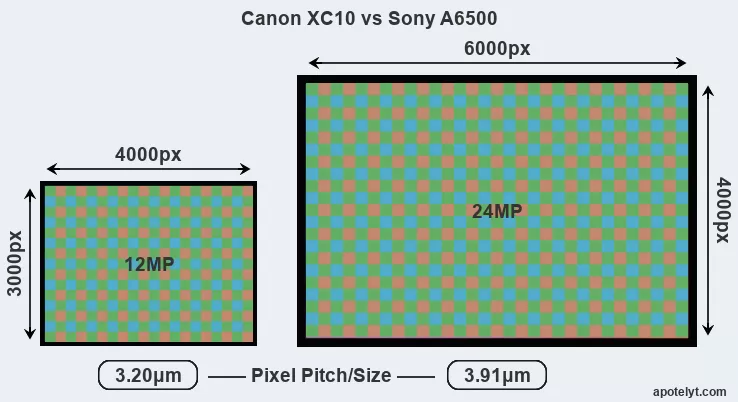
Consistent information on actual sensor performance is available from DXO Mark for many cameras. This service assesses and scores the color depth ("DXO Portrait"), dynamic range ("DXO Landscape"), and low-light sensitivity ("DXO Sports") of camera sensors, and also publishes an overall camera score. The table below summarizes the physical sensor characteristics and sensor quality findings and compares them across a set of similar cameras.

| Camera Model |
Sensor Class |
Resolution (MP) |
Horiz. Pixels |
Vert. Pixels |
Video Format |
DXO Portrait |
DXO Landscape |
DXO Sports |
DXO Overall |
||
|---|---|---|---|---|---|---|---|---|---|---|---|
| 1. | Canon XC10 | 1-inch | 12.0 | 4000 | 3000 | 4K/30p | 21.7 | 11.8 | 197 | 61 | |
| 2. | Sony A6500 | APS-C | 24.0 | 6000 | 4000 | 4K/30p | 24.5 | 13.7 | 1405 | 85 | |
| 3. | Canon G1 X Mark II | 1.5-inch | 13.0 | 4160 | 3120 | 1080/30p | 21.5 | 10.8 | 581 | 58 | |
| 4. | Canon G5 X | 1-inch | 20.0 | 5472 | 3648 | 1080/60p | 21.4 | 12.3 | 471 | 62 | |
| 5. | Canon G7 X | 1-inch | 20.0 | 5472 | 3648 | 1080/60p | 23.0 | 12.7 | 556 | 71 | |
| 6. | Canon G7 X Mark II | 1-inch | 20.0 | 5472 | 3648 | 1080/60p | 21.8 | 11.9 | 260 | 62 | |
| 7. | Canon G9 X | 1-inch | 20.0 | 5472 | 3648 | 1080/60p | 21.5 | 12.3 | 495 | 63 | |
| 8. | Canon SX60 | 1/2.3 | 14.2 | 4608 | 3072 | 1080/60p | 19.2 | 10.8 | 127 | 39 | |
| 9. | Fujifilm X30 | 2/3 | 12.0 | 4000 | 3000 | 1080/60p | 20.4 | 11.2 | -312 | 49 | |
| 10. | Nikon P900 | 1/2.3 | 15.9 | 4608 | 3456 | 1080/60p | 20.2 | 11.6 | 727 | 47 | |
| 11. | Olympus PEN-F | Four Thirds | 20.2 | 5184 | 3888 | 1080/60p | 23.1 | 12.4 | 894 | 74 | |
| 12. | Panasonic FZ2000 | 1-inch | 20.0 | 5472 | 3648 | 4K/30p | 23.0 | 12.6 | 538 | 70 | |
| 13. | Panasonic GX8 | Four Thirds | 20.2 | 5184 | 3888 | 4K/30p | 23.5 | 12.6 | 806 | 75 | |
| 14. | Panasonic LX100 | Four Thirds | 12.7 | 4112 | 3088 | 4K/30p | 22.3 | 12.5 | 553 | 67 | |
| 15. | Sony A6300 | APS-C | 24.0 | 6000 | 4000 | 4K/30p | 24.4 | 13.7 | 1437 | 85 | |
| 16. | Sony A6600 | APS-C | 24.0 | 6000 | 4000 | 4K/30p | 23.8 | 13.4 | 1497 | 82 | |
| 17. | Sony A6700 | APS-C | 25.6 | 6192 | 4128 | 4K/120p | 24.3 | 14.0 | 2329 | 86 | |
| Note: DXO values in italics represent estimates based on sensor size and age. | |||||||||||
Many modern cameras cannot only take still pictures, but also record videos. Both cameras under consideration have a sensor with sufficiently fast read-out times for moving pictures, and both provide the same movie specifications (4K/30p).
Feature comparison
Beyond body and sensor, cameras can and do differ across a range of features. For example, the A6500 has an electronic viewfinder (2359k dots), which can be very helpful when shooting in bright sunlight. In contrast, the XC10 relies on live view and the rear LCD for framing. The adjacent table lists some of the other core features of the Canon XC10 and Sony A6500 along with similar information for a selection of comparators.

| Camera Model |
Viewfinder (Type or 000 dots) |
Control Panel (yes/no) |
LCD Specifications (inch/000 dots) |
LCD Attach- ment |
Touch Screen (yes/no) |
Max Shutter Speed * |
Max Shutter Flaps * |
Built-in Flash (yes/no) |
Built-in Image Stab |
||
|---|---|---|---|---|---|---|---|---|---|---|---|
| 1. | Canon XC10 | none | n | 3.0 / 1030 | tilting | Y | 1/2000s | 3.8/s | n | Y | |
| 2. | Sony A6500 | 2359 | n | 3.0 / 922 | tilting | Y | 1/4000s | 11.0/s | Y | Y | |
| 3. | Canon G1 X Mark II | optional | n | 3.0 / 1040 | tilting | Y | 1/4000s | 5.2/s | Y | Y | |
| 4. | Canon G5 X | 2360 | n | 3.0 / 1040 | swivel | Y | 1/2000s | 5.9/s | Y | Y | |
| 5. | Canon G7 X | none | n | 3.0 / 1040 | tilting | Y | 1/2000s | 6.5/s | Y | Y | |
| 6. | Canon G7 X Mark II | none | n | 3.0 / 1040 | tilting | Y | 1/2000s | 8.0/s | Y | Y | |
| 7. | Canon G9 X | none | n | 3.0 / 1040 | fixed | Y | 1/2000s | 6.0/s | Y | Y | |
| 8. | Canon SX60 | 922 | n | 3.0 / 922 | swivel | n | 1/2000s | 6.4/s | Y | Y | |
| 9. | Fujifilm X30 | 2360 | n | 3.0 / 920 | tilting | n | 1/4000s | 12.0/s | Y | Y | |
| 10. | Nikon P900 | 921 | n | 3.0 / 921 | swivel | n | 1/4000s | 7.0/s | Y | Y | |
| 11. | Olympus PEN-F | 2360 | n | 3.0 / 1037 | swivel | Y | 1/8000s | 10.0/s | n | Y | |
| 12. | Panasonic FZ2000 | 2360 | n | 3.0 / 1040 | swivel | Y | 1/4000s | 12.0/s | Y | Y | |
| 13. | Panasonic GX8 | 2360 | n | 3.0 / 1040 | swivel | Y | 1/8000s | 10.0/s | n | Y | |
| 14. | Panasonic LX100 | 2764 | n | 3.0 / 921 | fixed | n | 1/4000s | 11.0/s | n | Y | |
| 15. | Sony A6300 | 2359 | n | 3.0 / 922 | tilting | n | 1/4000s | 11.0/s | Y | n | |
| 16. | Sony A6600 | 2359 | n | 3.0 / 922 | tilting | Y | 1/4000s | 11.0/s | n | Y | |
| 17. | Sony A6700 | 2360 | n | 3.0 / 1037 | swivel | Y | 1/4000s | 11.0/s | n | Y | |
| Note: *) Information refers to the mechanical shutter, unless the camera only has an electronic one. | |||||||||||
One difference between the cameras concerns the presence of an on-board flash. The A6500 has one, while the XC10 does not. While the built-in flash of the A6500 is not very powerful, it can at times be useful as a fill-in light.
The reported shutter speed information refers to the use of the mechanical shutter. Yet, some cameras only have an electronic shutter, while others have an electronic shutter in addition to a mechanical one. In fact, the A6500 is one of those camera that have an additional electronic shutter, which makes completely silent shooting possible. However, this mode is less suitable for photographing moving objects (risk of rolling shutter) or shooting under artificial light sources (risk of flickering).
The Canon XC10 has an intervalometer built-in. This enables the photographer to capture time lapse sequences, such as flower blooming, a sunset or moon rise, without purchasing an external camera trigger and related software.
The XC10 writes its imaging data to CFast or SDXC cards, while the A6500 uses SDXC or Memory Stick PRO Duo cards. The XC10 features dual card slots, which can be very useful in case a memory card fails. In contrast, the A6500 only has one slot. Both cameras can use UHS-I cards, which provide for Ultra High Speed data transfer of up to 104 MB/s.
Connectivity comparison
For some imaging applications, the extent to which a camera can communicate with its environment can be an important aspect in the camera decision process. The table below provides an overview of the connectivity of the Canon XC10 and Sony Alpha A6500 and, in particular, the interfaces the cameras (and selected comparators) provide for accessory control and data transfer.

| Camera Model |
Hotshoe Port |
Internal Mic / Speaker |
Microphone Port |
Headphone Port |
HDMI Port |
USB Port |
WiFi Support |
NFC Support |
Bluetooth Support |
||
|---|---|---|---|---|---|---|---|---|---|---|---|
| 1. | Canon XC10 | Y | stereo / mono | Y | Y | mini | 2.0 | Y | Y | - | |
| 2. | Sony A6500 | Y | stereo / mono | Y | - | micro | 2.0 | Y | Y | - | |
| 3. | Canon G1 X Mark II | Y | stereo / mono | - | - | mini | 2.0 | Y | Y | - | |
| 4. | Canon G5 X | Y | stereo / mono | - | - | mini | 2.0 | Y | Y | - | |
| 5. | Canon G7 X | - | stereo / mono | - | - | micro | 2.0 | Y | Y | - | |
| 6. | Canon G7 X Mark II | - | stereo / mono | - | - | micro | 2.0 | Y | Y | - | |
| 7. | Canon G9 X | - | stereo / mono | - | - | micro | 2.0 | Y | Y | - | |
| 8. | Canon SX60 | Y | stereo / mono | Y | - | mini | 2.0 | Y | Y | - | |
| 9. | Fujifilm X30 | Y | stereo / mono | - | - | micro | 2.0 | Y | - | - | |
| 10. | Nikon P900 | - | stereo / mono | - | - | micro | 2.0 | Y | Y | - | |
| 11. | Olympus PEN-F | Y | stereo / mono | - | - | micro | 2.0 | Y | - | - | |
| 12. | Panasonic FZ2000 | Y | stereo / mono | Y | Y | micro | 2.0 | Y | - | - | |
| 13. | Panasonic GX8 | Y | stereo / mono | Y | - | micro | 2.0 | Y | Y | - | |
| 14. | Panasonic LX100 | Y | stereo / mono | - | - | micro | 2.0 | Y | Y | - | |
| 15. | Sony A6300 | Y | stereo / mono | Y | - | micro | 2.0 | Y | Y | - | |
| 16. | Sony A6600 | Y | stereo / mono | Y | Y | YES | 2.0 | Y | Y | Y | |
| 17. | Sony A6700 | Y | stereo / mono | Y | Y | YES | 3.2 | Y | Y | Y |
Both the XC10 and the A6500 have been discontinued, but can regularly be found used on ebay. The XC10 was replaced by the Canon XC15, while the A6500 was followed by the Sony A6600. Further information on the features and operation of the XC10 and A6500 can be found, respectively, in the Canon XC10 Manual (free pdf) or the online Sony A6500 Manual.
Review summary
So what is the bottom line? Is the Canon XC10 better than the Sony A6500 or vice versa? Below is a summary of the relative strengths of each of the two contestants.

Advantages of the Canon XC10:
- Better sound control: Has a headphone port that enables audio monitoring while recording.
- More detailed LCD: Has a higher resolution rear screen (1030k vs 922k dots).
- Easier time-lapse photography: Has an intervalometer built-in for low frequency shooting.
- Ready to shoot: Has a lens built-in, whereas the A6500 requires a separate lens.
- Greater peace of mind: Features a second card slot as a backup in case of memory card failure.
- More heavily discounted: Has been on the market for longer (launched in April 2015).

Arguments in favor of the Sony Alpha A6500:
- More detail: Has more megapixels (24 vs 12MP), which boosts linear resolution by 44%.
- Better image quality: Is equipped with a larger and more technologically advanced sensor.
- Richer colors: The sensor size advantage translates into images with better, more accurate colors.
- More dynamic range: Larger sensor captures a wider spectrum of light and dark details.
- Better low-light sensitivity: Larger sensor produces good images even in poorly lit environments.
- Better live-view autofocus: Features on-sensor phase-detection for more confident autofocus.
- Easier framing: Has an electronic viewfinder for image composition and settings control.
- Faster shutter: Has higher mechanical shutter speed (1/4000s vs 1/2000s) to freeze action.
- Faster burst: Shoots at higher frequency (11 vs 3.8 flaps/sec) to capture the decisive moment.
- Less disturbing: Has an electronic shutter option for completely silent shooting.
- More flexible: Takes interchangeable lenses and can thus be used with specialty optics.
- More compact: Is smaller (120x67mm vs 125x102mm) and will fit more readily into a bag.
- Better sealing: Is splash and dust sealed for shooting in inclement weather conditions.
- Easier fill-in: Has a small integrated flash to brighten shadows of backlit subjects.
- More modern: Was introduced somewhat (1 year and 5 months) more recently.
If the count of individual advantages (bullet points above) is taken as a guide, the A6500 is the clear winner of the contest (15 : 6 points). However, the relative importance of the various individual camera aspects will vary according to personal preferences and needs, so that you might like to apply corresponding weights to the particular features before making a decision on a new camera. A professional wedding photographer will view the differences between cameras in a way that diverges from the perspective of a travel photog, and a person interested in cityscapes has distinct needs from a macro shooter. Hence, the decision which camera is best and worth buying is often a very personal one.
How about other alternatives? Do the specifications of the Canon XC10 and the Sony A6500 place the cameras among the top in their class? Find out in the latest Best Superzoom Camera and Best Mirrorless Interchangeable Lens Camera listings whether the two cameras rank among the cream of the crop.
In any case, while the specs-based evaluation of cameras can be instructive in revealing their potential as photographic tools, it says little about, for example, the shooting experience and imaging performance of the XC10 and the A6500 in practical situations. User reviews that are available, for instance, at amazon can sometimes shed light on these issues, but such feedback is all too often partial, inconsistent, and inaccurate.
Expert reviews
This is why hands-on reviews by experts are important. The adjacent summary-table relays the overall verdicts of several of the most popular camera review sites (amateurphotographer [AP], cameralabs [CL], digitalcameraworld [DCW], dpreview [DPR], ephotozine [EPZ], photographyblog [PB]). As can be seen, the professional reviewers agree in many cases on the quality of different cameras, but sometimes their assessments diverge, reinforcing the earlier point that a camera decision is often a very personal choice.

| Camera Model |
AP score |
CL score |
DCW score |
DPR score |
EPZ score |
PB score |
Camera Launch |
Launch Price |
Street Price |
||
|---|---|---|---|---|---|---|---|---|---|---|---|
| 1. | Canon XC10 | .. | .. | .. | 80/100 | .. | .. | Apr 2015 | EUR 2 199 | ebay.com | |
| 2. | Sony A6500 | 5/5 | + + | 3.5/5 | 85/100 | 4.5/5 | 4.5/5 | Oct 2016 | EUR 1 699 | ebay.com | |
| 3. | Canon G1 X Mark II | 3/5 | + | .. | 77/100 | 4/5 | 4.5/5 | Feb 2014 | EUR 849 | ebay.com | |
| 4. | Canon G5 X | 5/5 | + + | .. | 78/100 | 4.5/5 | 4.5/5 | Oct 2015 | EUR 789 | ebay.com | |
| 5. | Canon G7 X | 4/5 | + + | .. | 77/100 | 4.5/5 | 4.5/5 | Sep 2014 | EUR 649 | ebay.com | |
| 6. | Canon G7 X Mark II | 4.5/5 | + + | .. | 81/100 | 4.5/5 | 4.5/5 | Feb 2016 | EUR 685 | ebay.com | |
| 7. | Canon G9 X | 3.5/5 | + + | .. | .. | 4.5/5 | 4.5/5 | Oct 2015 | EUR 499 | ebay.com | |
| 8. | Canon SX60 | 3/5 | + + | .. | 75/100 | 4/5 | 4.5/5 | Sep 2014 | EUR 529 | ebay.com | |
| 9. | Fujifilm X30 | 4/5 | .. | .. | 76/100 | 4.5/5 | 4.5/5 | Aug 2014 | EUR 549 | ebay.com | |
| 10. | Nikon P900 | .. | .. | .. | 77/100 | 4/5 | 4/5 | Mar 2015 | EUR 619 | ebay.com | |
| 11. | Olympus PEN-F | .. | .. | 4/5 | 82/100 | 4.5/5 | 5/5 | Jan 2016 | EUR 1 199 | ebay.com | |
| 12. | Panasonic FZ2000 | .. | + | .. | 82/100 | 4.5/5 | 5/5 | Sep 2016 | EUR 1 249 | amazon.com | |
| 13. | Panasonic GX8 | 5/5 | + | .. | 82/100 | 4.5/5 | 4.5/5 | Jul 2015 | EUR 1 199 | ebay.com | |
| 14. | Panasonic LX100 | 5/5 | + + | .. | 85/100 | 5/5 | 5/5 | Sep 2014 | EUR 799 | ebay.com | |
| 15. | Sony A6300 | 4.5/5 | + | .. | 85/100 | 5/5 | 5/5 | Feb 2016 | EUR 1 099 | ebay.com | |
| 16. | Sony A6600 | 4/5 | + | 4/5 | 83/100 | 4.5/5 | 4/5 | Aug 2019 | EUR 1 599 | amazon.com | |
| 17. | Sony A6700 | 4.5/5 | + | 4.5/5 | 88/100 | 4.5/5 | 4.5/5 | Jul 2023 | EUR 1 699 | amazon.com | |
| Note: (+ +) highly recommended; (+) recommended; (o) reviewed; (..) not available. | |||||||||||
Care should be taken when interpreting the review scores above, though. The assessments were made in relation to similar cameras of the same technological generation. A score, therefore, has to be seen in close connection to the price and market introduction time of the camera, and rating-comparisons among cameras that span long time periods or concern very differently equipped models make little sense. It should also be noted that some of the review sites have over time altered the way they render their verdicts.

Check XC10 offers at
ebay.com

Check A6500 offers at
ebay.com
Other camera comparisons
Did this review help to inform your camera decision process? In case you would like to check on the differences and similarities of other camera models, just use the search menu below. As an alternative, you can also directly jump to any one of the listed comparisons that were previously generated by the CAM-parator tool.
- Canon 6D Mark II vs Canon XC10
- Canon SX60 vs Canon XC10
- Canon SX60 vs Sony A6500
- Canon T4i vs Sony A6500
- Canon XC10 vs Fujifilm X-T30
- Canon XC10 vs Panasonic FZ150
- Canon XC10 vs Sony A850
- Canon XC10 vs Sony A99
- Canon XSi vs Sony A6500
- Leica S2 vs Sony A6500
- Panasonic ZS100 vs Sony A6500
- Sony A3000 vs Sony A6500
Specifications: Canon XC10 vs Sony A6500
Below is a side-by-side comparison of the specs of the two cameras to facilitate a quick review of their differences and common features.
| Camera Model | Canon XC10 | Sony A6500 |
|---|---|---|
| Camera Type | Fixed lens compact camera | Mirrorless system camera |
| Camera Lens | 24-240mm f/2.8-5.6 | Sony E mount lenses |
| Launch Date | April 2015 | October 2016 |
| Launch Price | USD 2,499 | USD 1,399 |
| Sensor Specs | Canon XC10 | Sony A6500 |
| Sensor Technology | CMOS | CMOS |
| Sensor Format | 1" Sensor | APS-C Sensor |
| Sensor Size | 12.8 x 9.6 mm | 23.5 x 15.6 mm |
| Sensor Area | 122.88 mm2 | 366.6 mm2 |
| Sensor Diagonal | 16 mm | 28.2 mm |
| Crop Factor | 2.75x | 1.5x |
| Sensor Resolution | 12 Megapixels | 24 Megapixels |
| Image Resolution | 4000 x 3000 pixels | 6000 x 4000 pixels |
| Pixel Pitch | 3.20 μm | 3.91 μm |
| Pixel Density | 9.77 MP/cm2 | 6.55 MP/cm2 |
| Moiré control | Anti-Alias filter | Anti-Alias filter |
| Movie Capability | 4K/30p Video | 4K/30p Video |
| ISO Setting | 160 - 20,000 ISO | 100 - 25,600 ISO |
| ISO Boost | no Enhancement | 100 - 51,200 ISO |
| Image Processor | DIGIC DV5 | BIONZ X |
| DXO Sensor Quality (score) | .. | 85 |
| DXO Color Depth (bits) | .. | 24.5 |
| DXO Dynamic Range (EV) | .. | 13.7 |
| DXO Low Light (ISO) | .. | 1405 |
| Screen Specs | Canon XC10 | Sony A6500 |
| Viewfinder Type | no viewfinder | Electronic viewfinder |
| Viewfinder Field of View | 100% | |
| Viewfinder Magnification | 0.70x | |
| Viewfinder Resolution | 2359k dots | |
| LCD Framing | Live View | Live View |
| Rear LCD Size | 3.0inch | 3.0inch |
| LCD Resolution | 1030k dots | 922k dots |
| LCD Attachment | Tilting screen | Tilting screen |
| Touch Input | Touchscreen | Touchscreen |
| Shooting Specs | Canon XC10 | Sony A6500 |
| Focus System | Contrast-detect AF | On-Sensor Phase-detect |
| Manual Focusing Aid | Focus Peaking | Focus Peaking |
| Max Shutter Speed (mechanical) | 1/2000s | 1/4000s |
| Continuous Shooting | 3.8 shutter flaps/s | 11 shutter flaps/s |
| Electronic Shutter | no E-Shutter | YES |
| Time-Lapse Photography | Intervalometer built-in | no Intervalometer |
| Image Stabilization | Lens-based stabilization | In-body stabilization |
| Fill Flash | no On-Board Flash | Built-in Flash |
| Storage Medium | CFAST or SDXC cards | MS or SDXC cards |
| Single or Dual Card Slots | Dual card slots | Single card slot |
| UHS card support | UHS-I | UHS-I |
| Connectivity Specs | Canon XC10 | Sony A6500 |
| External Flash | Hotshoe | Hotshoe |
| USB Connector | USB 2.0 | USB 2.0 |
| HDMI Port | mini HDMI | micro HDMI |
| Microphone Port | External MIC port | External MIC port |
| Headphone Socket | Headphone port | no Headphone port |
| Wifi Support | Wifi built-in | Wifi built-in |
| Near-Field Communication | NFC built-in | NFC built-in |
| Body Specs | Canon XC10 | Sony A6500 |
| Environmental Sealing | not weather sealed | Weathersealed body |
| Battery Type | Canon LP-E6N | Sony NP-FW50 |
| Battery Life (CIPA) | 370 shots per charge | 350 shots per charge |
| In-Camera Charging | USB charging | USB charging |
| Body Dimensions |
125 x 102 x 122 mm (4.9 x 4.0 x 4.8 in) |
120 x 67 x 53 mm (4.7 x 2.6 x 2.1 in) |
| Camera Weight | 1040 g (36.7 oz) | 453 g (16.0 oz) |

Check XC10 offers at
ebay.com

Check A6500 offers at
ebay.com
Did you notice an error on this page? If so, please get in touch, so that we can correct the information.

